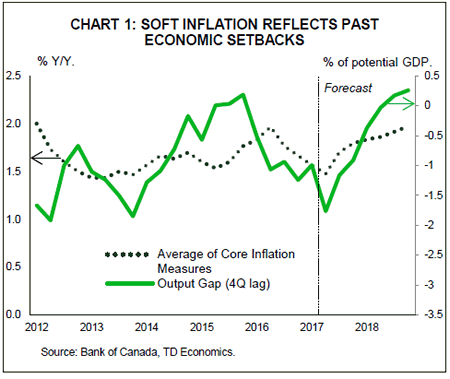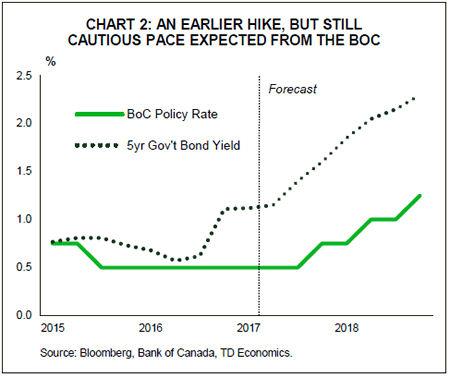HIGHLIGHTS OF THE WEEK
United States
- Markets were mixed on the week, seemingly undecided on how to score continued headlines from Washington, disappointing U.S. economic data, and the Fed’s confident tone accompanying its rate hike.
- The Fed anticipates that the recent softness in inflation to prove temporary. Its outlook for future rate hikes remained unchanged. We expect the process of reducing its balance sheet will begin in the fall, with a modest pace of rate hikes continuing thereafter.
- Other economic data this week was a tad on the soft side. But our outlook for the U.S. economy to post solid growth of 2.2% this year, and 2.1% next year has not changed, as a fundamentally strong consumer and better global growth help support the U.S. economy.
Canada
- Despite falling oil prices and soft equity markets, the loonie saw robust gains this week as investors digested a marked change in tone from the Bank of Canada.
- Bank of Canada communications this week suggested that the era of emergency level interest rates may end earlier than expected. It now appears likely that the first policy interest rate increase in more than six years will take place in October.
- Robust growth in recent quarters and a constructive outlook suggest that inflation is at or near a bottom, justifying the removal of some monetary accommodation. Only a gradual pace of policy rate increases is expected thereafter, reflecting the challenges still facing the Canadian economy.
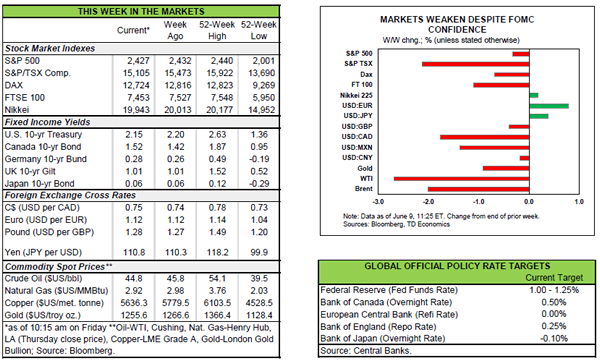
UNITED STATES – FED CASTS VOTE OF CONFIDENCE ON US ECONOMY
Markets weakened on the week, focusing on some disappointing U.S. economic data instead of the Fed’s confident tone accompanying its rate hike. The 25 basis-point increase in the fed funds rate was widely expected. More important was the vote of confidence cast by the Fed in its economic and inflation outlook. It left the number of rate hikes penciled in unchanged despite the loss of inflation momentum in recent months. The Fed also revealed more detailed plans for scaling back its holdings of Treasuries and MBS securities, describing the process for paring back the monthly amount of principal repayments it reinvests. We expect an announcement this September signaling this process to start in October. After that, the Fed is likely to next raise rates in December, and continue its gradual pace through 2018, provided the economy progresses as outlined in our latest forecast.
This was not a unanimous decision. President of the Minneapolis Fed, Neel Kashkari, dissented. He has written in the past that he is concerned about the Fed consistently missing on its inflation mandate, and would prefer to see more evidence that inflation pressures are building before hiking rates. He is not alone in this view. Many analysts suggest the Fed should wait to see greater evidence of inflation before acting to slow the economy. Financial markets aren’t totally convinced either (Chart 1). Given that inflation has fallen short of the Fed’s 2% target for the past five years, the skepticism is understandable.
Like many things in the post-financial crisis recovery, inflation pressures are proving slow to materialize. This phenomenon is not confined to the United States either. As discussed in our new Quarterly Economic Forecast, inflation readings across the G7 and key emerging markets have come in below expectations. Some of this reflects a pull-back in oil prices, but underlying core inflation measures have also undershot forecasts.
May’s CPI report provided further sustenance for the doves. Core inflation posted its lowest reading in two years, at 1.7% y/y. There was an encouraging firming in core services price pressures, ending the cooling in the prior two month but core goods prices remained in deflationary territory.
There is evidence that goods price pressures are building further up the supply chain. Producer and import prices are both pointing to higher prices for consumer goods in the coming months, as the effect of past U.S. dollar appreciation starts to wane. Moreover, domestic wage pressures have picked up over the past two years as the labor market has tightened (Chart 2). With job growth continuing to put downward pressure on unemployment, this is likely to continue. Eventually rising wages will squeeze profit margins and put upward pressure on inflation.
At this stage in the cycle we expect consumer spending growth to be increasingly driven by income gains. As such, real consumer spending growth should run at a solid 2-2.5% pace over the next two years. Although the May retail data was a bit soft, this was in part due to weak inflation. It does not derail the Q2 real consumer spending rebound. Nor does it change our expectation that, barring an unforeseen shock, the U.S. expansion is set to continue.
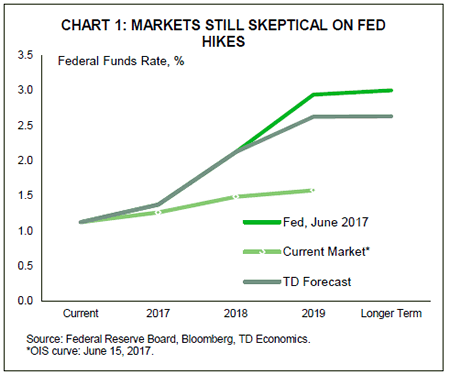
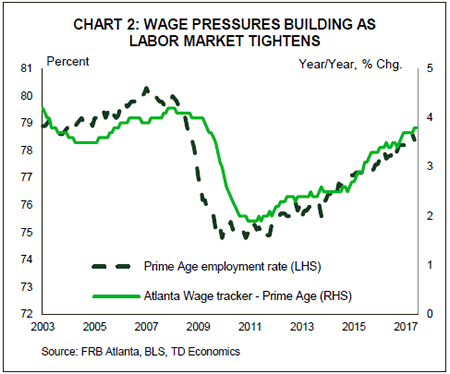
CANADA – BRIGHTER OUTLOOKS SETS STAGE FOR MONETARY TIGHTENING
It was a somewhat volatile week for Canadian markets, with declining oil prices helping lead the S&P/TSX index lower. Still, the loonie shook off the oil softness, and stood out as the star of the show. It climbed nearly half a cent vs the greenback Monday afternoon, and strengthened as the week went on, up nearly one cent by mid-morning Friday.
The key driver for the loonie’s strength was a marked shift in the tone of the Bank of Canada communications that served to bring forward market expectations of a policy rate increase, pushing longer-term interest rates modestly higher. The key trigger was a speech by Senior Deputy Governor Carolyn Wilkins (See our commentary). She suggested that the adjustment of the Canadian economy to lower oil prices was in the rear-view, and that despite persisting uncertainty "decisions must be taken" – marking a change in thinking.
Wilkins’ speech nevertheless appeared to leave a bit of ambiguity around just how quickly the Bank of Canada may begin to remove stimulus. This was quickly erased the next day when Governor Stephen Poloz appeared on CBC Radio, stating that "…people need to be thinking about what their finances would look like were interest rates to be a little higher when they renew their mortgage." The rapid change in communication tone, coupled with the unusual clarity in Poloz’s comments, points to a Bank that is getting ready to increase interest rates in the near future.
Is an increase in borrowing costs warranted? And if so, when and how quickly? The answer to the first question is a qualified "yes". The Canadian economy has been on a tear recently, posting 3.5% growth on average over the last three quarters. As outlined in the June edition of our Quarterly Economic Forecast, we expect growth to moderate slightly, but remain well above-trend through the remainder of this year. Clearly this is no longer an economy that requires emergency-level interest rates.
The qualification to the "yes" is related to inflation – not an unimportant detail given it is the sole monetary policy objective of the Bank. Despite robust growth, inflation remains stubbornly low, with the Bank of Canada’s measures of core or "underlying" inflation ticking lower recently. Still, this is likely to be more of a backward-looking measure as history suggests that these tend to lag output (Chart 1). From this standpoint, inflation appears close to turning the corner. Given that monetary policy is set not for the economy of ‘today’, but rather that of ‘tomorrow’, it is only logical the Bank of Canada will want to get ahead of any inflationary pressures to ensure that inflation remains as near the 2% target as possible. The first step towards this goal will be to bring their policy interest rate off its recent lows, likely at the October monetary policy announcement.
Even if Poloz and company are taking a more aggressive near-term approach, it remains likely that caution will rule the day for subsequent policy increases. Business investment has only begun to come back in any meaningful sense, while the adjustment process in the key Ontario/Toronto housing markets has only just begun. As a result, we expect any future hikes to be only gradual, with the policy rate reaching just 1.25% by the end of next year (Chart 2).
